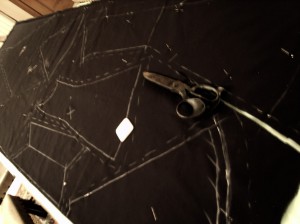
Submitting the recently begotten new asset to the test, by cutting out the individually chalk-transferred pattern pieces for the Marquis Coat; a task that still turned out to be quite a managerial challenge, as even with the extension onto a second fabric, the strictly right-thread-oriented placement of all the downwards widening pieces came out not a bit too liberal in filling out the available velour.
Cutting Cloth
Posted by Discipulus
on October 14, 2011

i still have to start everything, but i have some stupid question you might be able to help me with, can i overlock with a normal sewing machine? cause i leave my edges quiet raw atm (not that i care when i wear them) but it looks more professional if its overlocked, help?
It mostly depends on the fabric whether locking is needed or not. Woven fabrics (one thread over the other) usually shrivel easily but knitted fabric (threads hooked together) or leatherlikes do not.
So, locking the later types would be a bit pointless, as it takes up a lot of time and won’t really help your end-result.
In confection it is standard to leave the seams so short they have to be locked together to save them from ripping, but in general it looks a lot more professional to have 1 to 1.5 cm seam allowance left-in and have it properly ironed; open or both sides the same way.
To do a proper overlock you need a separate machine, which I believe is not that expensive, although I don’t currently have one myself.
On a regular machine you can just as well use a wide zig-zag program to lock your seams, making sure the needle catches the edge of the fabric with every other stitch.
The result (example shown here) works just as good as an overlock, especially on a heavier kind of fabric.
The only reason I’d consider getting an overlock-machine would be for the really fine fabrics, like veils and silks, where the tension of the zig-zag thread is too strong for the lightweight material, making it gather or run in places if done this way. So these, I’m afraid, are currently still being locked by hand. ^_^;
The last option is of course adding a lining to everything. Once the garment is finished, whatever cannot be touched or seen anymore cannot raffle on its own.
For the Red Shirt for instance I made sure to have very wide seams all ironed open, and left them that way, as the whole garment is finished off by lining.
Using a zig-zag to lock something delicate like this silk would have degraded the material, overlocking it professionally would have left unseemly marks when ironing the seams, and doing it by hand with such a number of pieces would have taken days to accomplish.
So seeing as this was a non-washable piece from the start, leaving the seams unlocked was always the most appropriate thing to do.
So, to sume it up for this coat; the velour pieces are knitted and do not need locking. The wool pieces are woven and were zigzagged before the garment is put in baste. The lining (woven) will most likely be left unlocked because nothing can get to it.
thank you so much ^^